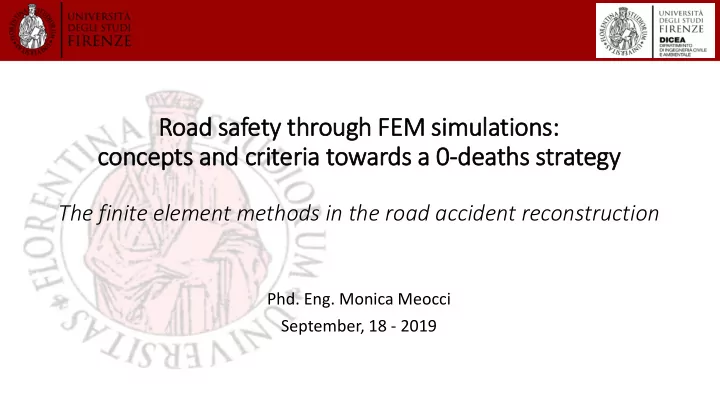

Road safety th through FEM sim imulations: concepts and cri riteria towards a 0-deaths str trategy The finite element methods in the road accident reconstruction Phd. Eng. Monica Meocci September, 18 - 2019
Accident reconstruction Objectives: Reconstruct, after the event, the dynamics of the accident in order to determine the pre-collision parametres: 1) Velocity of the vehicles involved in the occurrence; 2) Trajectors of the vehicles involved in the occurrence; 3) Injury level; 4) Responsability in the causation of the event. ROAD HOMICIDE 23/09/2019 FEM in Accident Reconstruction
Main methods Semi-empirical methods allows the determination of the speed pre-collision by means of equations obtained from experimental data i.e. full scale crash test, real events with camera, laboratory analysis Vehicle-pedestrian collision 23/09/2019 FEM in Accident Reconstruction
Vehicle-pedestrian collision 𝑊 = 𝑙 𝑒 km/h Happer m Appel Wood Input data: throw distance Distance between the collision point and the final position of pedestrian hit 23/09/2019 FEM in Accident Reconstruction
Vehicle-pedestrian collision 𝑊 = 13,3 𝑒 − 4,5 23/09/2019 FEM in Accident Reconstruction
Main methods Matemathical models Results obtained consequently the evaluation of the physical model representing the real phenomenon i.e. physical formulations Vehicle-pedestrian collision 23/09/2019 FEM in Accident Reconstruction
Main methods Ballistic motion S g / 2 x V 0 cos S tan h x h = height difference between launch and landing point S x = horizontal distance = starting angle 23/09/2019 FEM in Accident Reconstruction
Reconstruction by FEM Allow to: Evaluate all parametres but…It is necessary to know: Boundary condition … both velocities and directions (or hypothesis) For example 23/09/2019 FEM in Accident Reconstruction
Reconstruction by FEM Results: Damages Throw distance EES 23/09/2019 FEM in Accident Reconstruction
Reconstruction by FEM Results: Damages Throw distance 23/09/2019 FEM in Accident Reconstruction
Main methods Between two (or more vehicle) Conservation of momentum – 2 DoF m V cos( ) m V cos( ) m V cos( ) m V cos( ) 1 1 1 2 2 2 1 1 1 2 2 2 X and Y coordinates allow to define the position of the vehicle m V sen ( ) m V sen ( ) m V sen ( ) m V sen ( ) 1 1 1 2 2 2 1 1 1 2 2 2 Input: known parametres Results of the system V V , , , , , 1 2 1 2 1 2 V 1 V e 2 23/09/2019 FEM in Accident Reconstruction
Main methods Between two (or more vehicle) Conservation of momentum – 3 DoF 8 different equations X, Y and angle allow to define the position of the vehicle Input: known parametres Results of the system V , V , , 1 2 1 2 23/09/2019 FEM in Accident Reconstruction
When??? … when the problem can’t be represented in 2 dimension The main examples can be summarized follow: - Vehicle rollower; - Definition the position of the occupants; - Collision with road restraint systems (definition of the energy dissipation) - ..in the other cases the methodology can be applayed with an improve of computational cost if compared ofthe traditional methods. 23/09/2019 FEM in Accident Reconstruction
When??? … when the problem can’t be represented in 2 dimension The main examples can be summarized follow: - Vehicle rollover; - Definition the position of the occupants; - Collision with road restraint systems (definition of the energy dissipation) ..in the other cases the methodology can be applayed with an improve of computational cost if compared with traditional methods. 23/09/2019 FEM in Accident Reconstruction
When??? Rollover 23/09/2019 FEM in Accident Reconstruction
When??? Occupant ’ position 23/09/2019 FEM in Accident Reconstruction
When??? 23/09/2019 FEM in Accident Reconstruction
When??? Road restraint system collision 23/09/2019 FEM in Accident Reconstruction
When??? Road restraint system collision 23/09/2019 FEM in Accident Reconstruction
Severity of the collision 23/09/2019 FEM in Accident Reconstruction
Recommend
More recommend